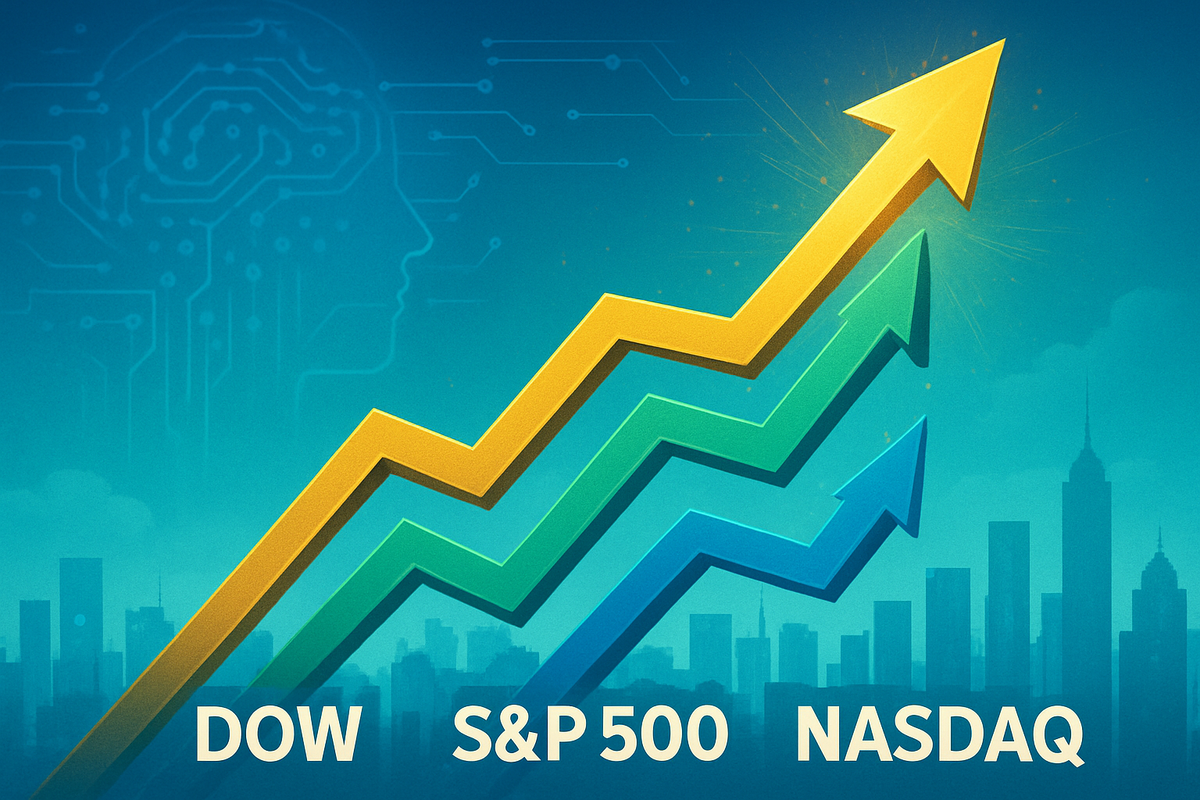
In a historic display of market strength, the Dow Jones Industrial Average (DJIA), S&P 500 (SPX), and Nasdaq Composite (IXIC) have all simultaneously achieved new record highs as of October 29, 2025. This synchronized rally signifies a period of robust investor confidence and a distinctly bullish outlook for the global economy, driven by a powerful confluence of strong corporate earnings, particularly from the technology and artificial intelligence (AI) sectors, renewed optimism for a U.S.-China trade resolution, and the persistent expectation of accommodative monetary policy from the Federal Reserve.
The immediate implications are overwhelmingly positive, characterized by a "risk-on" frenzy and heightened optimism among investors. While the broad market is clearly experiencing a surge, a closer look reveals a significant concentration of gains within specific, high-growth sectors. This raises questions about the true breadth of the rally and whether it signals sustainable, widespread economic health or the dominance of a select few industry leaders.
A Synchronized Ascent: Unpacking the Market's Record-Breaking Run
The simultaneous ascent of the Dow, S&P 500, and Nasdaq to new record highs is a testament to the powerful forces currently shaping the financial landscape. This remarkable achievement, occurring on October 29, 2025, follows a period of sustained growth fueled by several key factors. Corporate earnings have been a primary driver, with roughly one-third of S&P 500 companies reporting so far, and an impressive 83% beating forecasts. This strong performance, particularly from technology and AI giants, has instilled a renewed sense of confidence among investors.
The timeline leading up to this moment has been marked by increasing optimism surrounding a potential breakthrough in US-China trade relations. Reports of a "very successful framework" for a comprehensive agreement have further fueled investor confidence, prompting a reallocation of capital into equities. Additionally, the market is largely pricing in a 25-basis-point interest rate cut at the conclusion of the FOMC meeting on October 29, with expectations of further cuts extending into 2026. This dovish stance from the Federal Reserve creates a favorable monetary environment for equity valuations, further encouraging market participation.
Key players in this rally include the aforementioned technology behemoths such as Nvidia (NVDA), Microsoft (MSFT), Apple (AAPL), and Amazon (AMZN), whose robust earnings and continued innovation in AI have been instrumental in driving the Nasdaq's surge. Beyond tech, companies like UPS (UPS) and Wayfair (W) have also seen significant jumps after exceeding earnings estimates, highlighting broader strength in various sectors. Initial market reactions have been euphoric, with a pervasive "risk-on tone" across markets, encouraging capital inflows and generating a palpable sense of "fear of missing out" (FOMO) among investors.
Winners and Losers in a Bull Market
The current synchronized market rally presents a clear distinction between potential winners and those who might struggle to keep pace. Unsurprisingly, the technology and AI sectors stand to be the biggest beneficiaries. Companies at the forefront of AI development and implementation, such as Nvidia (NASDAQ: NVDA), Microsoft (NASDAQ: MSFT), and Alphabet (NASDAQ: GOOGL), are experiencing unprecedented growth, with their valuations soaring as investors pour capital into what they perceive as the future of innovation. These companies are likely to continue their upward trajectory as AI integration expands across industries, further solidifying their market dominance. Semiconductor manufacturers and cloud computing providers are also poised for significant gains, as they form the foundational infrastructure for AI.
Conversely, companies with less exposure to the rapidly expanding AI and technology sectors, or those operating in more traditional, slower-growth industries, might find themselves comparatively disadvantaged. While the overall market is up, the concentration of gains in tech could mean that other sectors experience more modest growth, or even capital outflows as investors chase higher returns elsewhere. Furthermore, highly leveraged companies or those sensitive to potential shifts in interest rate policy could face headwinds if the Federal Reserve's dovish stance were to unexpectedly change, even slightly.
Investors holding portfolios heavily weighted towards established, value-oriented companies might see their returns lag behind those focused on growth and technology. While these companies may offer stability, the current market dynamic favors disruptive innovation. However, it's also worth noting that a rising tide lifts all boats to some extent, and even companies outside the tech spotlight may benefit from the broader economic optimism and increased consumer spending that often accompanies a strong bull market. The challenge for these companies will be to demonstrate their own avenues for growth and relevance in an increasingly tech-driven economy.
Broader Significance and Historical Context
This synchronized rally, with the Dow, S&P 500, and Nasdaq all reaching new peaks, fits squarely into a broader industry trend of technological advancement and a global economy increasingly reliant on innovation. The AI revolution, in particular, is not merely a sector-specific phenomenon but a transformative force reshaping industries from healthcare to manufacturing. This event underscores the accelerating pace of digital transformation and the market's conviction in the long-term growth prospects of companies leading this charge. The ripple effects are profound, impacting competitors who must now accelerate their own AI strategies or risk obsolescence, and partners who stand to gain from increased collaboration and technological integration.
From a regulatory standpoint, the increasing dominance of a few tech giants could invite greater scrutiny regarding market concentration and anti-trust concerns. Policymakers may feel compelled to examine the competitive landscape and ensure fair play, potentially leading to new regulations or enforcement actions. However, as of October 29, 2025, the focus remains largely on fostering innovation and economic growth. Historically, periods of synchronized market highs have often been followed by continued growth in the short to medium term, although with increased volatility. The current scenario draws parallels to the late 1990s dot-com boom, where technology stocks experienced rapid appreciation, though analysts are quick to point out fundamental differences in today's corporate earnings and technological maturity.
Comparisons to previous bull markets suggest that while the current momentum is strong, investors should remain vigilant. The "risk-on" sentiment has led to a reallocation of capital from traditional safe-haven assets, with gold and silver prices experiencing declines. This shift indicates a reduced immediate concern about broader economic instability. However, the elevated valuations, particularly in the AI and tech sectors, warrant careful consideration. The market's current trajectory is a powerful affirmation of technological progress and economic resilience, but it also necessitates a nuanced understanding of underlying drivers and potential vulnerabilities.
What Comes Next: Navigating the Future Market Landscape
Looking ahead, the short-term outlook for the market appears largely optimistic, with many analysts anticipating a continuation of the rally into late 2025 and early 2026. The expectation of further interest rate cuts from the Federal Reserve, coupled with the potential for a U.S.-China trade resolution, provides a favorable macroeconomic backdrop. However, this period of heightened growth is also expected to be accompanied by increased volatility. Investors should prepare for potential market fluctuations as the global economic landscape continues to evolve.
In the long term, companies across all sectors will need to adapt strategically to the ongoing technological shifts. Those that embrace AI and integrate it effectively into their operations are likely to thrive, while those that lag could face significant challenges. This could necessitate strategic pivots, increased investment in research and development, and a focus on upskilling workforces. New market opportunities will undoubtedly emerge, particularly in areas related to AI infrastructure, ethical AI development, and specialized applications across various industries.
Potential scenarios range from a continued, albeit more volatile, bull run, to a market correction if economic data or geopolitical events take an unexpected turn. Key watchpoints include any shifts in the Fed's monetary policy, the progress of U.S.-China trade negotiations, and the ongoing U.S. government shutdown, which, if prolonged, could impact investor confidence. While the current environment is ripe with opportunity, a prudent approach involves diversifying portfolios, staying informed about market developments, and carefully assessing risk.
A New Era of Market Dynamics: Wrapping Up the Rally
The synchronized record highs of the Dow, S&P 500, and Nasdaq mark a pivotal moment in financial history, signaling a new era of market dynamics. The key takeaway is the undeniable strength of the current bull market, driven by robust corporate earnings and favorable macroeconomic conditions. While reflecting broad investor confidence, the rally also underscores the significant lean towards the technology and AI sectors, highlighting their increasingly central role in global economic growth.
Moving forward, the market is poised for continued, albeit potentially more volatile, growth. Investors should remain attentive to the interplay of technological advancements, monetary policy, and geopolitical developments. The sustained momentum and record highs are likely to continue generating a "fear of missing out" among investors, drawing more capital into the market. However, concerns about elevated valuations, particularly in the AI and tech sectors, warrant careful monitoring of market stability.
What investors should watch for in the coming months includes any shifts in the Federal Reserve's stance on interest rates, the progress of international trade negotiations, and the continued performance of corporate earnings, especially from the leading technology companies. The lasting impact of this synchronized rally could be a fundamental re-evaluation of traditional market drivers, with innovation and technological disruption taking an even more prominent role in shaping investment strategies and economic outcomes.
This content is intended for informational purposes only and is not financial advice





